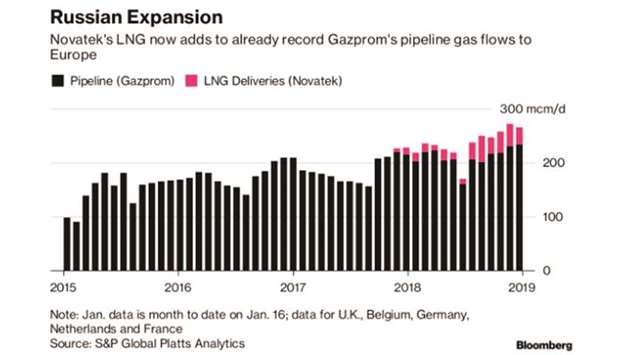Russia’s two biggest natural gas producers have for years competed only at home, but that rivalry has unexpectedly spilled into Europe.
Instead of shipping liquefied natural gas to Asia from a new Siberian plant, lower prices meant Novatek PJSC sent most of those supplies to northern Norway, where it is transferred and taken to European markets. The shipments encroach on a region state-owned Gazprom PJSC has dominated for decades just as it faces increased competition from new suppliers including the US.
“Many people think there was a truce between Novatek and Gazprom to not touch the European market, to save the price for Gazprom,” said Jean-Baptiste Dubreuil, a senior natural gas analyst at the International Energy Agency. “Recently there has been a lot of reloads from Norway, which ended up in some markets in northwest Europe in direct competition with Gazprom.’’
Although Gazprom is unlikely to lose its crown in Europe, where it is pumping record volumes to offset declining domestic production and meets more than a third of demand, the increased LNG supply may force it to pare back some flows or risk lower prices. That would be another blow for the state-owned company after Novatek last year briefly overtook it in terms of market capitalisation, despite its far superior production and reserves and its monopoly on Russian pipeline gas exports.
Gazprom and Novatek declined to comment.
Shrinking prices for LNG in Asia made it more attractive for shippers to land the fuel in Europe. That’s expected to remain the case through the next winter. The result is that most of the fuel shipped from Novatek’s Yamal plant has ended up in Europe since the facility started more than a year ago, though some has gone to other regions. The plan was for those supplies to mainly head to Asian markets, which usually offer a premium for the fuel.
Other pipeline-gas suppliers to Europe, such as Norway, Algeria and the Netherlands, have already had to make room to accommodate that extra gas, but Gazprom’s volumes haven’t yet been impacted, said James Huckstepp, lead European gas analyst at S&P Global Platts. Gazprom has also topped up sales under long-term contracts with volumes sold on electronic platforms.
“Those platform sales have shifted toward those northwestern European markets, which have seen also an uptick of LNG deliveries,” Huckstepp said in a telephone interview. “It is definitely an area where there is the most competition between the two sources.”
The Yamal LNG has also meant Europe’s dependency on Russian gas has increased but supplies from other sources, including US LNG, have also risen. As the year progresses with a more comfortable storage situation in Europe than last year, Gazprom is unlikely to maintain its record flows, while Yamal LNG volumes will continue to stay in Europe, according to S&P Global Platts.
“We are expecting a pullback of Russian gas at least from the very strong levels that we saw over the last year as we go into summer 2019,” Huckstepp said, envisaging a decline of 24mn cubic meters per day in the summer and also a contraction next winter. “Part of that is down to the amount of LNG coming to Europe.”

Graph
